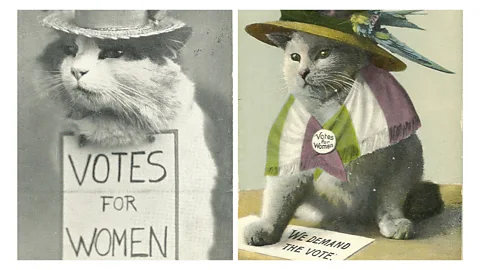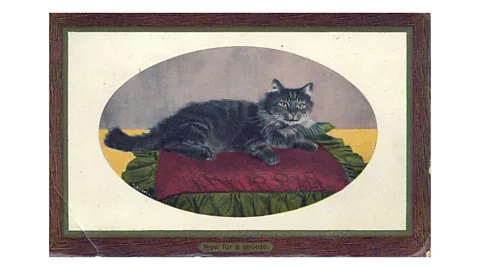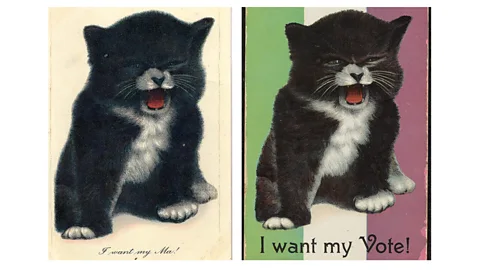'Postcards are the email of their day': How cat memes went viral 100 years ago
 From the Collection of Ann Lewis and Myron Sponder
From the Collection of Ann Lewis and Myron SponderIn the age of social media, we're living through a communications revolution. But this isn't the first one, nor is it the first time cats have been at the centre of social change.
It is a fundamental law of media history: as soon as a new communications technology emerges, people will use it to make pictures of cats. And those cat pictures show not only the special relationship between humans and their pets, but the changing ways that humans relate to one another.
Cat memes in their modern form date back to the 1990s, when email first allowed bored office workers and friends to message each other funny felines. The cats jumped from there to social media as the web developed, where viral videos like Keyboard Cat and memes such as Grumpy Cat bloomed across platforms. Demand for this content was so high that entire websites like ICanHasCheezburger sprung up to showcase the best e-cats, aggregating popular pet videos and cat memes.
But there was another trend long before any cat wanted to "has cheezburger", or any owner could even imagine taking a video of their pet with a handheld electronic rectangle: the Edwardian postcard. And, according to scholars of media history, understanding the cat postcards of the early 20th Century might help us to understand social media today.
 Courtesy of the Edwardian Postcard Project, Lancaster University
Courtesy of the Edwardian Postcard Project, Lancaster University"Some things persist across generations and media, and depictions of cats are one of those things. It's kind of reassuring," says Ben Weiss, a senior curator at the Boston Museum of Fine Arts, and co-curator of the museum's The Postcard Age exhibition.
In the 19th and early 20th Century, Weiss says, "postcards functioned like social media today". Cheaper, faster and more convenient than a letter, postcards were used to share random musings, plan logistics for where and when to meet, tell jokes and, as always, post cat pictures. Whether it's mail sent with a stamp in 1924 or posts made with the tap of a finger in 2024, cats of all forms have always been there for artists and audiences.
The first postcards were printed in Austria-Hungary in 1869 – fortuitous timing for an innovation in the mail field because in 1874, 21 countries established the Universal Postal Union, allowing mail to be sent and delivered internationally. More countries followed in the years to come, and postcards rode this wave.
 Courtesy of the Edwardian Postcard Project, Lancaster University
Courtesy of the Edwardian Postcard Project, Lancaster UniversityLike memes, postcards carried not just a picture and a few lines of text but were tangible evidence of a vast network and powerful institutions that had transported them rapidly across a far distance. They marked a changing world and technology's startling advance, delivered daily into the hands and mailboxes of citizens.
"We've forgotten the density of that early 20th-Century communications network, which postcards were moving through," says Weiss. "You could send a postcard to someone at 10 saying you'll be there at 5:30, if you're going from Manhattan to Jersey City, and you can get the message to them fairly quickly."
Postcards in the early 20th-Century city arguably marked the first time in history that communication at that speed was affordable and widely accessible to the average person. Between 1900 and 1914, says Weiss, "there's this massive worldwide postcard craze to the point where people talk about it being a disease in the public bloodstream".
During this era of postcard mania, uncountable millions of postcards circulated, and it was a perfect moment for cats to take over the new medium. At the time cats were considered more than just pest control. Monarchs and socialites, including Queen Victoria, were famous cat enjoyers, and the animal's association with Halloween was well-established. Some postcards featured cats just being cats: sipping milk from saucers, playing with yarn, basking in the sunlight. Others dressed cats up as humans, working jobs and taking part in domestic scenes.
Not everybody was comfortable with the postcard's impact on society. Newspapers called it a "fresh terror" and a "Frankenstein's monster", alarmed by the product's popularity, says Monica Cure, author of Picturing the Postcard: A New Media Crisis at the Turn of the Century. The sacks of postal workers swelled with postcards, leading to stories about injuries from lifting overladen mail bags.
 Lancaster University/ The Johns Hopkins University
Lancaster University/ The Johns Hopkins University"Postcards were seen as so fast," Cure says. "There were lots of complaints about what postcards were going to do to people's reading and writing skills, because if you could just dash off a few lines, why did you need to actually learn grammar and become a good writer">window._taboola = window._taboola || []; _taboola.push({ mode: 'alternating-thumbnails-a', container: 'taboola-below-article', placement: 'Below Article', target_type: 'mix' });
